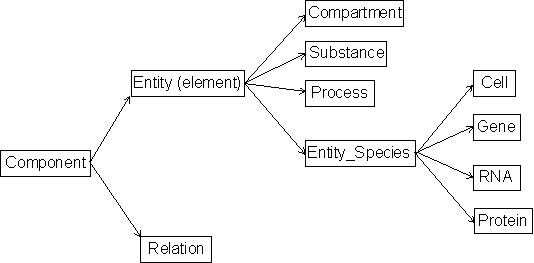|
[an error occurred while processing this directive]
|
Main principles
A chemical formalism was employed as a basis for describing the events
occurring in the gene network. Thus, any event is described as follows:

where:
- A - the entities entering into reaction
- B - the products of reaction
- C - the entities affecting the course of reaction
Basing on this model, we consider two types of relationships between
entities:
- Reaction (indicated by double arrow) - the interaction between the
entities that leads to the appearance of a new entity, assembly or disassembly of a
multimeric complex, expression of a protein, or secretion of certain substances. Protein
modifications are also assigned to this class (for example, the transition of a protein to
an active state as a result of phosphorylation).
- Regulatory event (single arrow) - the effect of an entity (it may be regarded as
a catalyst or inhibitor) on a certain reaction. Regulatory events of four types are
distinguished depending on their effect on the reaction:
- switch on.
Example: protein kinase catalyzes the dissociation of the transcription factor/inhibitor
complex that leads to transcription factor activation.
- switch off.
Example: the effect of the repressor protein.
- positive effect.
Example: enhancement of the gene expression by the transcription factor.
- negative effect.
Example: weakening of the gene transcription by the inhibitor.
The combined effect of several entities can be different from the
effect of each entity alone (for instance, the synergistic effect of transcription factors
within a composite element on gene expression). This type of reaction is referred to as
‘complex’. Thus, simple and complex relations are distinguished.

Class hierarchy of the GeneNet database. The arrows point from a general class to a
more specific class of objects.
Following to described above chemical formalism all gene network
components are devided in two classes:
Currently seven types of entities are described in the GeneNet database:
- Compartment - any cell or organism compartment. Examples of cell
compartments are cytoplasmic membrane, cytoplasm, endoplasatic reticulum,
mitochondrion, nucleus. Examples of organism compartments are different tissues and
organs.
- Substance - any chemical substance or compound.
- Process - some general proccess some phisical influence. Examples of
general processes are virus infection, starvation, anemia, hypoxia. Examples of phisical
influence are light, heat.
- Cell - any cell or cell lineage. In certain cases some tissues and
organs are also considered as cells.
- Gene - any gene
- RNA - any RNA..
- Protein - any protein or protein complex.
It should be noted that objects of last for classes (Cell, Gene, RNA, Protein)
are species specific and thus this classes are derivated from Entity_Species class.
|
